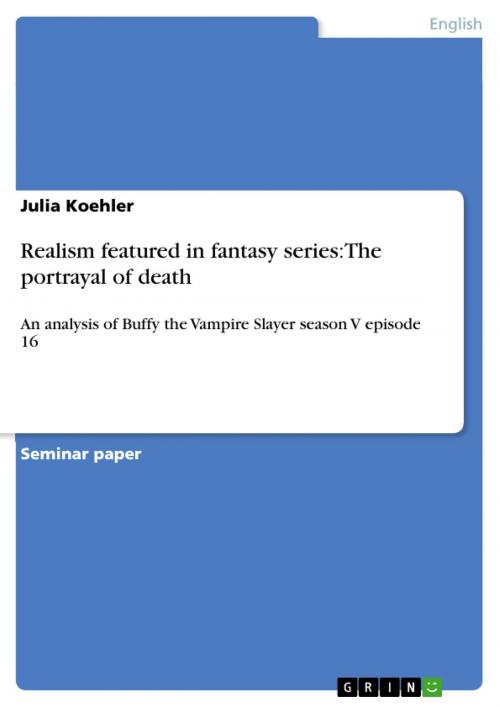Realism featured in fantasy series:The portrayal of death
An analysis of Buffy the Vampire Slayer season V episode 16
Nonfiction, Entertainment, Drama, Anthologies| Author: | Julia Koehler | ISBN: | 9783638009508 |
| Publisher: | GRIN Publishing | Publication: | February 25, 2008 |
| Imprint: | GRIN Publishing | Language: | English |
| Author: | Julia Koehler |
| ISBN: | 9783638009508 |
| Publisher: | GRIN Publishing |
| Publication: | February 25, 2008 |
| Imprint: | GRIN Publishing |
| Language: | English |
Seminar paper from the year 2007 in the subject American Studies - Miscellaneous, grade: 2,0, Free University of Berlin (JFK), course: 'Framing Reality':The Hollywood Representation of Broadcast News Journalism., 20 entries in the bibliography, language: English, abstract: 'It was pretty much the blond girl in the alley in the horror movie who keeps getting killed ... I felt bad for her, but she was always much more interesting to me than the other women. She was fun, she had sex, she was vivacious. But then she would get punished for it. Literally, I just had that image, that scene, in my mind, like the trailer for a movie what if the girl goes into that dark alley. And the monster follows her. And she destroys him.' This quote taken from Joss Whedon, creator and executive producer of the television series Buffy the Vampire Slayer (1997-2003), shows his interest in establishing an absolutely new type of show where a heroine - an apparently average high-school girl - is the focus of the storyline. Nineteen-year old Buffy Summers (Sarah Michelle Gellar) personifies the Chosen One to save the world from dreadful demons, nasty vampires and other scary supernatural creatures. How Buffy copes with her duty as a Slayer, how she manages to overcome the separations from her two former boy-friends Angel and Riley and how she deals with her capricious teenage sister Dawn - all that can be learned during seasons one through five of Buffy the Vampire Slayer. This paper, however, focuses on an extraordinary episode in mid-season V called The Body, where we are confronted with an utterly vulnerable protagonist facing death and attempting to come to terms with the result of her mother's passing away. This paper's intention is to show how and why Joss Whedon decided to make Buffy's mother Joyce die on screen and to explore its significance for the story's plot. My assumption is that this crucial impact was indispensable for the development of Buffy's character as well as for her relationship with her younger sister Dawn. As Buffy's father having deserted the familiy after his divorce from Joyce and taking off to live in Italy, it is Buffy's duty to take care of her sister and assume full responsibility for her after their mother's sudden death. That process of maturity leads gradually to the very end of season V where in the final episode The Gift Buffy sacrifices her own life in order to spare Dawn's.
Seminar paper from the year 2007 in the subject American Studies - Miscellaneous, grade: 2,0, Free University of Berlin (JFK), course: 'Framing Reality':The Hollywood Representation of Broadcast News Journalism., 20 entries in the bibliography, language: English, abstract: 'It was pretty much the blond girl in the alley in the horror movie who keeps getting killed ... I felt bad for her, but she was always much more interesting to me than the other women. She was fun, she had sex, she was vivacious. But then she would get punished for it. Literally, I just had that image, that scene, in my mind, like the trailer for a movie what if the girl goes into that dark alley. And the monster follows her. And she destroys him.' This quote taken from Joss Whedon, creator and executive producer of the television series Buffy the Vampire Slayer (1997-2003), shows his interest in establishing an absolutely new type of show where a heroine - an apparently average high-school girl - is the focus of the storyline. Nineteen-year old Buffy Summers (Sarah Michelle Gellar) personifies the Chosen One to save the world from dreadful demons, nasty vampires and other scary supernatural creatures. How Buffy copes with her duty as a Slayer, how she manages to overcome the separations from her two former boy-friends Angel and Riley and how she deals with her capricious teenage sister Dawn - all that can be learned during seasons one through five of Buffy the Vampire Slayer. This paper, however, focuses on an extraordinary episode in mid-season V called The Body, where we are confronted with an utterly vulnerable protagonist facing death and attempting to come to terms with the result of her mother's passing away. This paper's intention is to show how and why Joss Whedon decided to make Buffy's mother Joyce die on screen and to explore its significance for the story's plot. My assumption is that this crucial impact was indispensable for the development of Buffy's character as well as for her relationship with her younger sister Dawn. As Buffy's father having deserted the familiy after his divorce from Joyce and taking off to live in Italy, it is Buffy's duty to take care of her sister and assume full responsibility for her after their mother's sudden death. That process of maturity leads gradually to the very end of season V where in the final episode The Gift Buffy sacrifices her own life in order to spare Dawn's.















